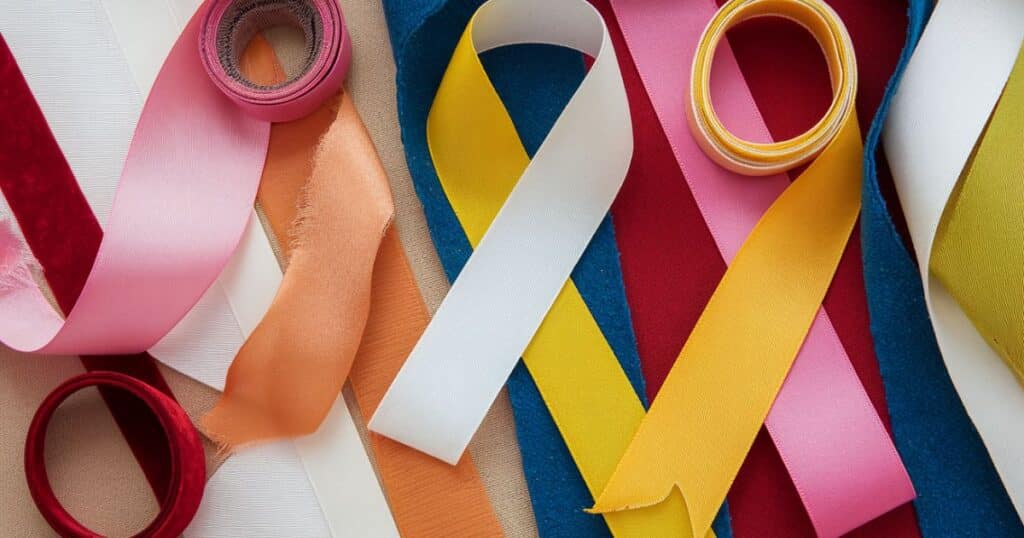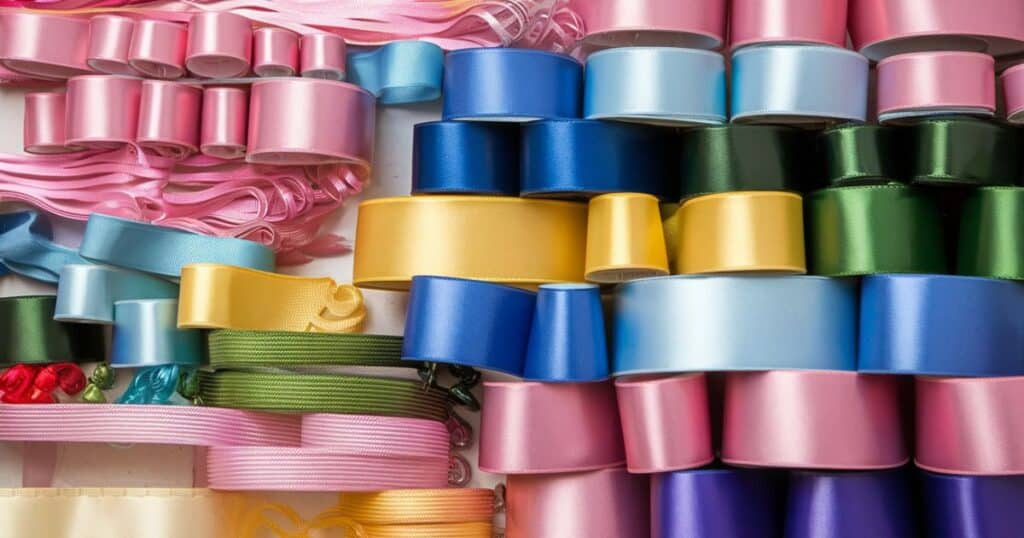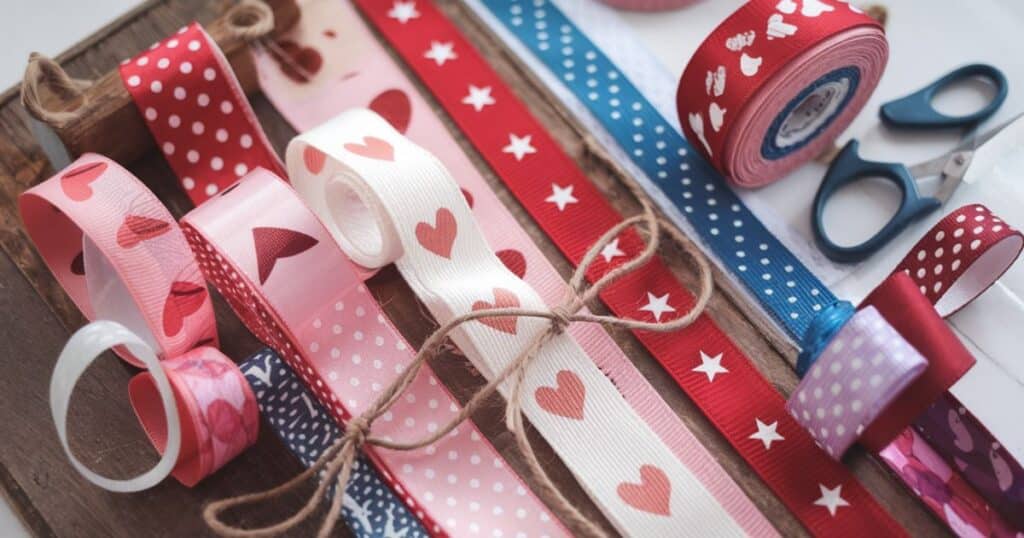The soft rustle of ribbon unfurling from a spool, the precise measurement before the scissors snip these small moments connect us to centuries of craft traditions.
Whether you’re wrapping a birthday gift, creating a wedding invitation, or putting the finishing touch on a handmade quilt, ribbon adds that perfect accent.
But have you ever wondered why ribbons come in such specific sizes? Or found yourself standing in a craft store, overwhelmed by the dizzying array of widths and lengths available?
Ribbon sizing isn’t just random it’s evolved through practical application and artistic necessity.
From the delicate 1/8-inch ribbons adorning vintage lockets to the bold 4-inch sashes crowning pageant winners, each size serves a distinct purpose.
Understanding these dimensions can transform your crafting experience from frustrating to fulfilling.
How to Measure Ribbon Sizes
Ribbon measurements typically focus on two key dimensions: width and length. Width is particularly crucial as it determines a ribbon’s appropriate uses and aesthetic impact.
When crafters discuss ribbon sizes, they’re usually referring to the width measurement, which typically ranges from the whisper-thin 1/8 inch to statement-making 4 inches or wider.
To visualize these widths, consider everyday objects: 1/4-inch ribbon compares to a pencil’s diameter, while 1-inch ribbon matches the width of a standard paperclip. These comparisons help crafters make quick decisions without constantly reaching for a ruler.
Common Ribbon Width Sizes and Their Uses
Micro Ribbons (1/8 inch – 1/4 inch)
These delicate ribbons create subtle accents that whisper rather than shout. The 1/8-inch ribbon barely wider than a wooden matchstick adds refined detail to wedding invitations, bookmark tassels, and dainty jewelry projects.
Scrapbookers often reach for these slim strips to frame photos without overwhelming the page composition.
Designer Kate Williams explains, “I use 1/8-inch silk ribbon for the delicate rosettes on my bridal collections. The narrow width creates incredibly realistic miniature flowers that would be impossible with wider ribbons.
” This precision makes micro ribbons indispensable for detailed needlework and miniature craft projects.
One fascinating bit of history: Victorian-era mourning lockets often contained thin ribbons precisely cut to 1/8 inch, which were used to secure small locks of hair from departed loved ones a testament to how these narrow ribbons have served emotionally significant purposes throughout history.
Narrow Ribbons (3/8 inch – 5/8 inch)
These versatile ribbons strike the perfect balance between subtlety and visibility. A 3/8-inch ribbon approximately the width of a standard pencil eraser commonly adorns gift packages, creates hair accessories, and enhances scrapbook pages.
The 5/8-inch ribbon has become an icon of awareness campaigns worldwide. The pink breast cancer awareness ribbon, measured precisely at 5/8 inch, has become one of the most recognizable symbols in modern philanthropy.
This width provides enough visual impact while remaining comfortable when worn as a pin.
Ribbon historian Thomas Reed notes, “The 5/8-inch width became standardized for military service ribbons during World War II, as it was determined to be the ideal size for recognition without overpowering the uniform.
” This width has since become the international standard for military and achievement ribbons.
Medium Ribbons (7/8 inch – 1 1/2 inch)
When impact matters, crafters turn to medium-width ribbons. The 7/8-inch ribbon comparable to the width of a standard guitar pick creates substantial gift bows, borders craft projects, and forms the backbone of corsages and boutonnieres.
Wedding planners particularly favor the 1 1/2-inch ribbon for chair sashes and ceremony décor. This width creates a substantial visual statement while maintaining an elegant proportion.
Floral designer Julia Chen shares, “For bridal bouquet streamers, I exclusively use 1 1/2-inch silk ribbon. This width photographs beautifully and creates the perfect cascade effect as the bride walks.”
Medium ribbons trace their lineage to practical applications. The standard 1-inch grosgrain ribbon became a staple in clothing manufacturing during the 1950s, reinforcing waistbands in everything from everyday dresses to haute couture.
This industrial application explains the abundant availability of this particular width.
Wide Ribbons (2 inch – 4 inch)
When making a statement is essential, wide ribbons deliver dramatic impact. The 2-inch ribbon about the width of a standard credit card creates luxurious gift packaging, dramatic wedding pew decorations, and striking costume elements.
Interior designers often utilize 3-inch ribbons as trim for draperies and upholstery. This width creates sufficient visual weight to anchor large design elements while maintaining the fluid characteristics that make ribbon distinctive from other trim options.
Pageant sashes typically measure 4 inches wide a dimension carefully selected to ensure text remains legible while the sash maintains a flattering drape across the body.
This standardization emerged in the 1920s and remains consistent across international competitions.
Ceremonial ribbon-cutting events typically feature 4-inch ribbons for a fascinating reason: this width provides optimal visibility for photographs while ensuring the ribbon doesn’t overwhelm the participants holding it.
This pragmatic consideration shows how ribbon sizes evolve to serve specific functional needs.

Specialty Ribbon Sizes
Beyond standard widths, specialty ribbons serve unique purposes:
French Wired Ribbon
French wired ribbon incorporates thin wire along both edges, typically in widths from 1 1/2 inches to 4 inches.
This construction allows the ribbon to hold sculptural shapes, making it ideal for advanced bow-making, holiday decorations, and floral arrangements that require structural support.
Luxury florist Michael Thompson explains, “The 2 1/2-inch wired ribbon creates the perfect cascading bouquet effect for brides. The wire allows me to create gentle curves that mimic the natural fall of flowers something impossible with standard ribbon.”
Picot Edge Ribbon
These ribbons feature tiny loops along the edges, typically in narrow widths between 1/8 inch and 3/8 inch. The delicate edging prevents fraying while adding subtle texture, making them perfect for heirloom sewing projects and children’s clothing embellishments.
Costume historian Elena Rodriguez notes that picot edge ribbons gained popularity during the Edwardian era for lingerie trimmings, where the scalloped edge created a feminine finish that resisted fraying through repeated launderings.
Double-Faced Satin Ribbon
Available in widths ranging from 1/8 inch to 4 inches, double-faced satin ribbon features a lustrous finish on both sides. This construction makes it ideal for projects where both sides remain visible, such as hair bows, gift wrapping, and apparel accents.
Bridal designer Christopher Parks shares, “For ceremonies, I exclusively use 2-inch double-faced satin for the handfasting ribbon. The symbolic nature of the ceremony requires a ribbon that presents beautifully from all angles as the couple’s hands are bound together.”
Measuring Ribbon Length
While width measurements remain standardized, ribbon length varies enormously based on application and packaging:
Ribbon Spools and Rolls
Craft stores typically sell ribbon in standardized lengths:
- Small spools: 3-5 yards
- Medium spools: 10-25 yards
- Large rolls: 50-100 yards
Professional decorators and floral designers often purchase ribbon by the roll, with lengths of 50+ yards being common for large events.
Wedding coordinator Elise Johnson reveals, “For a typical 150-guest wedding with chair sashes, table runners, and bouquet streamers, we calculate approximately 150 yards of ribbon. Understanding these quantities prevents last-minute panic purchases.”
See Also: Thank You Card Sizes (Standard & Other Sizes)
Cut Lengths
For specific projects, ribbon may be sold in pre-cut lengths:
- Hair bow lengths: 18-36 inches
- Gift wrapping lengths: 30-60 inches
- Corsage ribbons: 12-24 inches
Practical Applications of Different Ribbon Sizes
Gift Wrapping
The perfect gift wrap ribbon varies by package size:
- Small gift boxes: 3/8 inch to 5/8 inch
- Medium presents: 7/8 inch to 1 1/2 inch
- Large packages: 2 inch to 4 inch
Professional gift wrapper Sophia Kim advises, “The ribbon width should be approximately 1/8 the width of your package for visual harmony. This proportion creates the most aesthetically pleasing presentation.”

Crafting and Scrapbooking
Different projects require specific ribbon widths:
- Photo corners: 1/8 inch to 1/4 inch
- Page borders: 3/8 inch to 5/8 inch
- Book binding: 1/2 inch to 1 inch
Scrapbooking champion Darcy Wells explains, “I keep a ribbon organizer sorted by width rather than color. When designing layouts, the width is actually more important than shade for achieving proper visual balance.”
Floral Design
Floral applications utilize ribbon strategically:
- Boutonnieres: 1/4 inch to 3/8 inch
- Corsages: 5/8 inch to 7/8 inch
- Bridal bouquets: 1 inch to 2 inch
- Ceremonial arrangements: 2 inch to 4 inch
Master florist Hiroko Tanaka notes, “The ribbon width should never compete with the flowers it should complement them. For delicate blooms like lily of the valley, I never use ribbon wider than 3/8 inch.
See Also: Samsonite Suitcase Sizes: A Complete Guide
How to Measure Ribbon Without a Ruler
When a measuring tape isn’t handy, these everyday objects provide reliable ribbon width references:
- Credit card width: 2 1/8 inches
- Dollar bill width: 2 5/8 inches
- Smartphone width: Typically 2 1/2 to 3 inches
- Standard paper clip: About 1 inch when straightened
- Pencil diameter: Approximately 1/4 inch
For length measurements:
- Dollar bill length: 6 1/8 inches
- Standard printer paper: 11 inches (short side), 8 1/2 inches (long side)
- Arm span from fingertip to opposite shoulder: Approximately 1 yard
Craft teacher Martha Jimenez shares, “I teach my students to use their own hands for quick measurements. The width across your thumb knuckle is about 1 inch for most adults, while the distance from thumb tip to first knuckle is roughly 1 inch.”
Choosing the Right Ribbon Size for Your Project
Selecting the optimal ribbon size involves considering several factors:
Visual Impact
- Subtle accent: 1/8 inch to 1/4 inch
- Balanced embellishment: 3/8 inch to 1 inch
- Statement piece: 1 1/2 inch to 4 inch
Practical Considerations
- Tying capabilities: Narrower ribbons (under 1/2 inch) tie tighter knots and smaller bows
- Durability needs: Wider ribbons (over 1 inch) provide stronger structural support
- Surface area for printing: Ribbons for personalized messages typically need at least 5/8 inch width
Material Interaction
Fashion designer Roberto Vega explains, “Different ribbon materials behave differently at various widths. Silk ribbon wider than 2 inches often becomes unwieldy, while grosgrain maintains its shape beautifully even at 4 inches wide.”

The Cultural Significance of Ribbon Sizes
Ribbon sizes carry surprising cultural significance around the world:
- Military ribbons: Standardized at precisely 35mm (approximately 1 3/8 inches) across most NATO countries
- Championship ribbons: Horse show rosettes feature streaming ribbons in graduated widths, with central ribbons at 2 inches
- Cultural ceremonies: Japanese obi ribbons for traditional dress measure approximately 5 inches wide
Anthropologist Dr. Fatima Al-Sayegh notes, “In many Middle Eastern cultures, ribbon width directly correlates to the formality of an occasion. Wider ribbons appear at weddings and significant celebrations, while narrow ribbons suffice for everyday gifts.”
Ribbon Size Trends Through History
Ribbon widths have fluctuated with fashion trends:
- Victorian era (1837-1901): Favored narrow ribbons (1/8 inch to 1/4 inch) for delicate trimmings on women’s clothing
- Art Deco period (1920s-1930s): Embraced wider ribbons (2 inch to 3 inch) for bold geometric designs
- Mid-century modern (1950s-1960s): Standardized medium ribbons (5/8 inch to 1 inch) for practical applications
- Contemporary period: Celebrates the full spectrum of ribbon widths, with particular emphasis on extreme contrasts
Fashion historian Dr. Marcus Chen observes, “You can accurately date historical garments by examining the ribbon widths used in their construction. The 1870s briefly favored extraordinarily wide ribbons of up to 6 inches for sashes, a width rarely seen before or since.”
Conclusion
Understanding ribbon sizes transforms ordinary crafting into precision artistry. From the whisper-thin 1/8-inch ribbons adorning wedding invitations to the bold 4-inch sashes making ceremonial statements, each width serves specific aesthetic and functional purposes.
Next time you browse the ribbon aisle, you’ll recognize the intentional design behind each width. Whether you’re wrapping a gift, creating a floral arrangement, or finishing a craft project, choosing the right ribbon size elevates your creation from amateur to artisanal.
Look around your home how many different ribbon widths can you identify? That Christmas gift with the perfect bow, the special occasion corsage preserved in a memory box, the bookmark with its elegant tassel all showcase the thoughtful selection of ribbon size that often goes unnoticed but makes all the difference.
Read more knowledgeable blogs on Measure Take.



